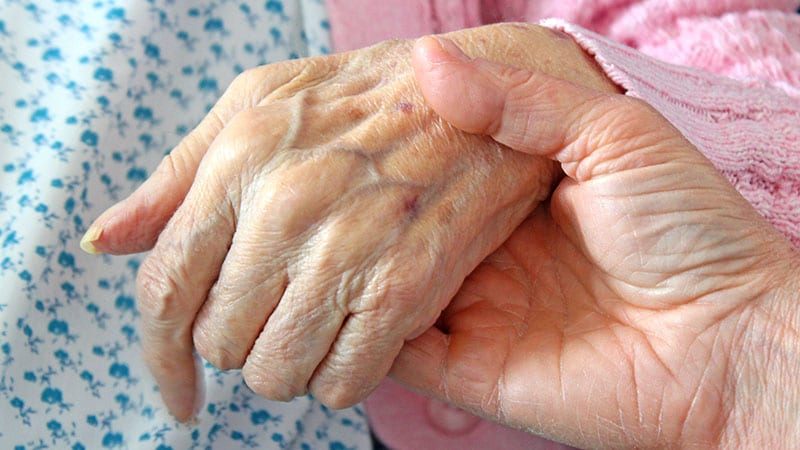Elderly patients with atrial fibrillation (AF) who are at high risk of bleeding may benefit from a low 15-mg dose of edoxaban, regardless of their frailty status, a subanalysis of the ELDERCARE-AF trial suggests.
Major bleeding and major or clinically relevant nonmajor bleeding events were both numerically higher in the edoxaban group than placebo, the authors report, with no heterogeneity by frailty status.
The subanalysis extends findings of the overall study by teasing out stroke, systemic embolism (SSE) and bleeding events across frailty status among Japanese patients age 80 and older who were ineligible for oral anticoagulants (OACs) at usual doses.
Findings from the original phase 3 ELDERCARE-AF study were previously reported during the virtual European Society of Cardiology Congress 2020 and simultaneously published in The New England Journal of Medicine. The current study was published online August 23 in JAMA Network Open.
All Frailty Levels Benefited
Shintaro Akashi, MD, PhD, of National Hospital Organization Hamada Medical Center, Shimane, Japan, and colleagues analyzed data from 944 patients randomly assigned to edoxaban 15 mg or placebo for about 3 years. The mean age of participants was 86.6 years and 57% were women. Baseline characteristics, including history of bleeding, were similar between groups.
Patient physical condition was assessed using five parameters: weight loss, grip strength, walking speed, exhaustion, and activity level. This yielded a frailty score, with 1 point given for each parameter: 0 indicated robust; 1 or 2, prefrail; and 3 or higher, frail. For this analysis, robust (6.5% of patients) and prefrail (51%) were combined and categorized as nonfrail.
In the placebo group, estimated event rates for stroke or SSE were 7.1% per patient-year among frail patients and 6.1% per patient-year among those who were nonfrail.
In the edoxaban group, SSE occurred at an estimated event rate of 2.5% of frail patients and 1.5% of nonfrail patients (adjusted HR, 1.41).
The edoxaban group “consistently had fewer SSE events regardless of frailty status including each frailty assessment parameter, and there was no heterogeneity between the groups,” the authors write, with similar trends for the association of edoxaban 15 mg for each frailty assessment parameter.
However, major bleeding and major or clinically relevant nonmajor (CRNM) bleeding events were both higher with edoxaban, regardless of frailty status.
More specifically, in the placebo group, the incidence of major bleeding was 2.3% in the frail group and 1.5% in the nonfrail group (adjusted HR, 1.48) versus 3.7% and 2.9%, respectively, in the edoxaban group (adjusted HR, 1.04).
In addition, exhaustion was related to a significantly increased risk of major or CRNM bleeding in frail versus nonfrail patients (16.3% vs 8.4%; adjusted HR, 1.97). The incidences were all higher in the edoxaban group, irrespective of frailty status.
Furthermore, although both all-cause death and the net clinical composite outcome of stroke or SSE occurred more frequently in frail than in nonfrail patients, there was no association with frailty status between the edoxaban and placebo groups.
Findings unrelated to edoxaban were also noteworthy. “Surprisingly, grip strength showed an association with adverse events,” the authors write. Among those with lower grip strength, “there was nearly a 3-fold increase in risk of SSE and major bleeding and a more than 16-fold significant increase in risk of death. In addition, in those with exhaustion, there was nearly a 2-fold significant increase in major or CRNM bleeding.”
Thus, they suggest, in this patient population, “an objective physical assessment of grip strength or exhaustion in addition to the well-known walking speed may more accurately estimate the risks of clinical outcomes than the overall frailty assessment.”
Head-to-Head Comparisons Needed
Commenting on the findings for theheart.org | Medscape Cardiology, Richard Kovach, MD, chair of the Interventional Cardiology Division at Deborah Heart and Lung Center, Browns Mills, New Jersey, said, “It is interesting that the lower dose of edoxaban still appears to have a statistically significant reduction in the incidence of stroke in this subgroup of extremely frail elderly patients, and it may be useful in this highly selected subset.”
“That being said,” he added, “the major complication of oral anticoagulants — major bleeding — appears to be similar to other NOACs prescribed more frequently in the US, specifically rivaroxaban and apixaban.”
“Furthermore, in the US, frail or complex patients who are not candidates for oral anticoagulant therapy are much more likely to receive a left atrial appendage closure device such as a Watchman or Amulet in order to avoid the risk of bleeding complications completely,” he said. “Procedural success with these devices is extremely high and procedural complications are extremely low. With both devices, the long-term reduction in stroke risk is equivalent to the use of anticoagulant therapy.”
“Clearly, more research is needed to compare the outcomes with edoxaban against other NOACs,” Kovach concluded. “A head-to-head comparison of low-dose edoxaban versus left atrial appendage closure in this high-risk group would also be of great clinical value.”
The study was funded by Daiichi Sankyo. Two coauthors are employees of and five have received fees from the company. Kovach has reported no relevant financial relationships.
JAMA Netw Open. Published online August 23, 2022. Full text
Follow Marilynn Larkin on Twitter: @MarilynnL
For more from theheart.org | Medscape Cardiology, follow us on Twitter and Facebook.
Source: Read Full Article
